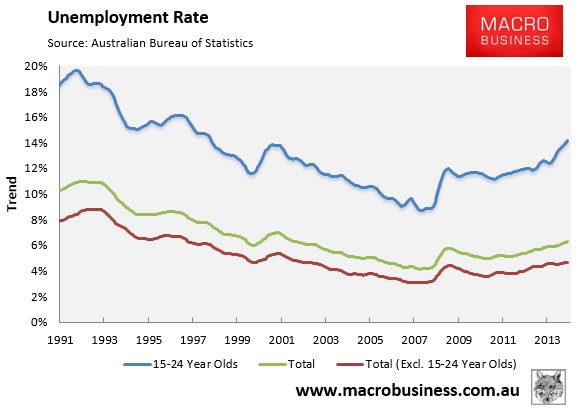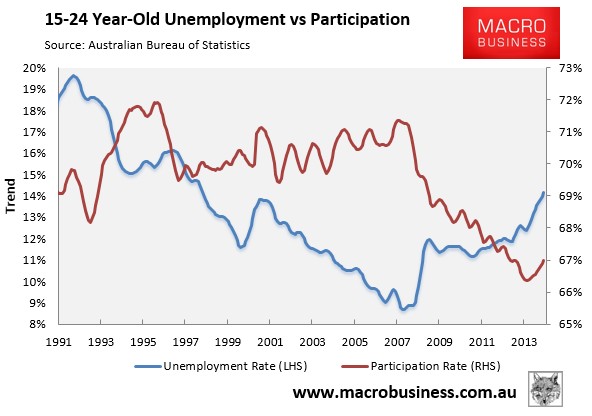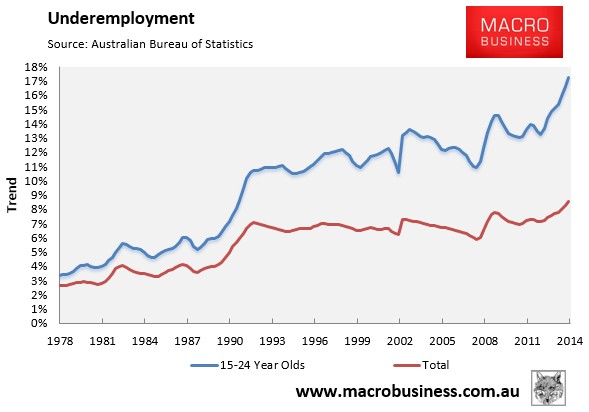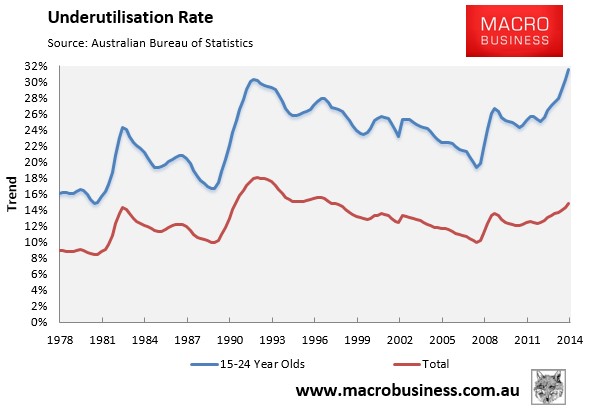I wrote last week how Australia’s youth labour market has hit crisis levels, with unemployment for those aged 15 to 24 years old at 14.1% in November in trend terms – the highest level in over 16-years – versus only 4.7% for the rest of the labour force (see next chart).

To add insult to injury, this deterioration in the unemployment rate comes despite the collapse in the labour force participation rate since the GFC, suggesting considerable hidden youth unemployment:

Youth underemployment, which captures those employed part-time that would like more work, also hit the highest level on record in November, coming it at 17.2% for 15 to 24 year-olds compared with 8.5% for the labour market as a whole (see next chart).

Meanwhile, when the number of unemployed and underemployed youth are added together, underutilisation amongst Australia’s 15 to 24 year-olds hit a whopping 31.6% in November – the highest level on record, even beating the early-1990s recession (see next chart).

Finally, since the GFC, overall youth employment has fallen by 5.9% in trend terms, despite the strong lift in the population over this time, with full-time jobs down an incredible 17.7%. By contrast, the overall number of jobs for the rest of the labour force has risen by 10.7%, with full-time employment up 7.6% (see below table).

Today, Fairfax has reported that youth unemployment is set to deteriorate even further as the weak economy takes its toll on new job seekers:
Stephen Walters, JP Morgan chief economist, said for the unemployment rate to stand still at 6.3 per cent Australia needed to create about 15,000 jobs every month.
“[But] it’s difficult when your economy’s just not growing at the speed limit, which we’re not doing, so that means unemployment’s going to go up,” Mr Walters said.
“Underemployment and youth unemployment are both worrying, and both rising. We know there’s a lot of people who want to work full time but are [only] working part time, and even though we got a good employment gain last week all of it came from part-time employment. Virtually nothing at all came from full time.”
Saul Eslake, Bank of America Merrill Lynch chief economist, said the loss of income that Australia was experiencing at the moment due to large falls in commodity prices was having “real and tangible consequences” for the labour market and would continue to do so next year.
“The government’s collecting less tax because people and companies are earning less income, and if they’re earning less income they’re almost certainly going to be spending less and employing fewer people,” Mr Eslake said.
“The basic story is that the economy is continuing to generate jobs, but not enough to absorb all of the new entrants to the labour force. And that’s why the rise in unemployment is being disproportionately felt among the young because they dominate new entrants to the workforce.”
As I keep arguing, now is definitely not the time for the Abbott Government to deny under-30s access to unemployment benefits, nor deregulate business’ access to 457 “temporary skilled” migrant visas.
When combined with expected increasing levels of automation, Australia’s youth are already facing a very difficult employment future, and do not require further barriers.

